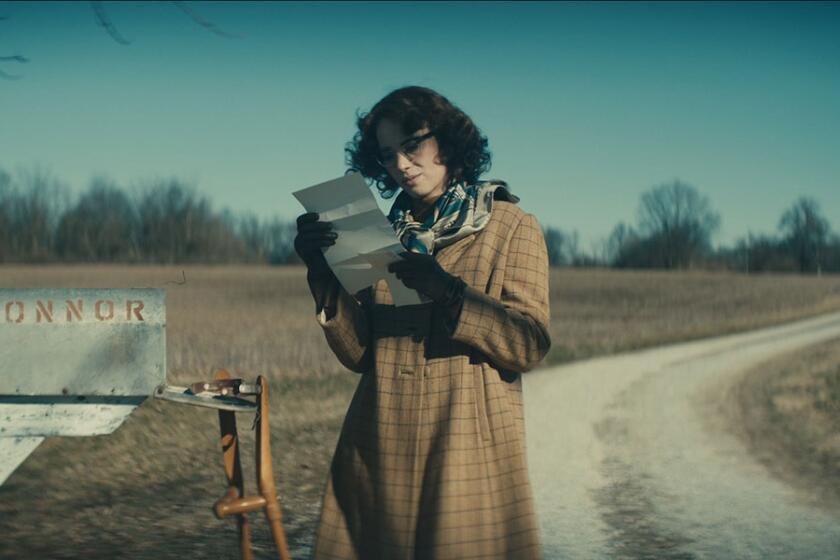Movie review: ‘Exit Through the Gift Shop’
Subversive, provocative and unexpected, “Exit Through the Gift Shop” delights in taking you by surprise, starting quietly but ending up in a hall of mirrors as unsettling as anything Lewis Carroll’s Alice ever experienced. Even when you think you’ve figured this film out, you can’t shake the notion that maybe you haven’t.
No director or screenwriters are listed in “Gift Shop’s” credits, just the words “A Banksy Film,” which refer to the notoriously secretive British street artist and master provocateur who’s become world famous without giving up his anonymity. Banksy, or at least someone who plausibly claims to be Banksy, opens this film, his head hooded, his face in deep shadow, his voice electronically altered, but with the whip-smart and iconoclastic nature of his intelligence on full display as he talks about the film’s subject, Los Angeles art world figure Thierry Guetta. “He tried to make a film about me, but I made a film about him,” Banksy says, adding enigmatically, “He was a lot more interesting than I am.”
Banksy’s website calls “Exit Through the Gift Shop” “the world’s first street art disaster movie,” which is about as good a description of this singular documentary as we’re going to get. Like revenge, it’s a dish best served cold, which means you’ll want to see it knowing as little as possible; on the other hand, its story has so much resonance that the film rewards multiple viewings.
Seeming to tell one story but at one point switching over to another that’s been lurking in the shadows, “Exit Through the Gift Shop” folds together as slowly and artfully as an origami sculpture. Anyone who’s ever been to an exhibition at a major museum will recognize the implications of the title and understand that the film serves in part as a caustic jeremiad on the rampant commercialization of the art world. But that is only the beginning.
For the more you think about this unusual film, the more fascinating it becomes culturally and sociologically, dealing with notions of mania and obsession, art and commerce, hype and quality. While on one level it ends up talking about how susceptible we are as a culture to the mindless blandishments of the new, it also raises — half against its will, perhaps — questions of what is art and what is not, what is substantial and of value and what is complete trash, and, just as important, who gets to decide which is which.
These questions end up taking us by surprise, because “Exit Through the Gift Shop” starts simply with the fascinating but seemingly straightforward story, narrated by actor Rhys Ifans, of one man and the compelling world he fell into almost without realizing it.
That man would be French-born Guetta, who owned a vintage clothing store on Melrose Avenue and never went anywhere without a video camera. As Guetta, whose interview footage is a key component of the film, puts it, “It was obsession more than any drug to anyone.”
On a family visit to France, Guetta discovered that one of his cousins, known professionally as both Invader and Space Invader, was one of the first major players in a new movement that came to be known as street art and involved clandestinely and illegally putting up graffiti-like stencils and wall art on random public spaces.
Because this work was both arduous and unlawful, and because by its nature it was often short-lived, the street artists were in need of accomplices who could help with the work and video operators who could record what they’d done. The up-for-anything Guetta fit both bills nicely.
Back in Los Angeles, he connected through Space Invader to such top people as Shepard Fairey, who considered him “passionate and kind of crazy”; if it does nothing else, “Gift Shop” provides priceless vérité footage showing all manner of street artists at work in the dead of night and the wee hours of the morning.
Working with the elusive Banksy, a man who, the voice-over dryly informs, was “taking vandalism in an entirely new direction,” became Guetta’s goal. Eventually, the connection was made, and one of the real treats of this film is watching this mysterious artist at work. We see footage of Banksy pulling off a daring anti-Guantanamo prank at Disneyland and watch open-mouthed as he shows Guetta a million British pounds’ worth of fake 20 pound notes with Princess Di’s picture where the queen’s ought to be.
During the decade Guetta was filming, street art became big business, something that makes Banksy uncomfortable even as he profits from it. What happens next, and what made Banksy decide to turn the tables and make a film about Guetta, has to be seen to be believed. Or not.
On the one hand, it is certainly more than plausible that Guetta’s story could have happened exactly the way it is presented in “Gift Shop.” That narrative would at the very least give the artist who once clandestinely hung his own paintings in London’s Tate Modern a chance to tweak the art world establishment one more time. “Maybe,” Banksy muses near the end of the film, “it means art is a bit of a joke.”
It is also possible, as reflected in Web rumors that Banksy was inspired to make this film by Orson Welles’ “F for Fake,” that this story as a whole or in parts is some kind of giant prank or elaborate performance piece that Guetta is either a witting or unwitting participant in. Only the ever elusive Banksy knows for sure, but he’s not really talking. Either way, this is a doc you don’t want to miss.
More to Read
Only good movies
Get the Indie Focus newsletter, Mark Olsen's weekly guide to the world of cinema.
You may occasionally receive promotional content from the Los Angeles Times.







